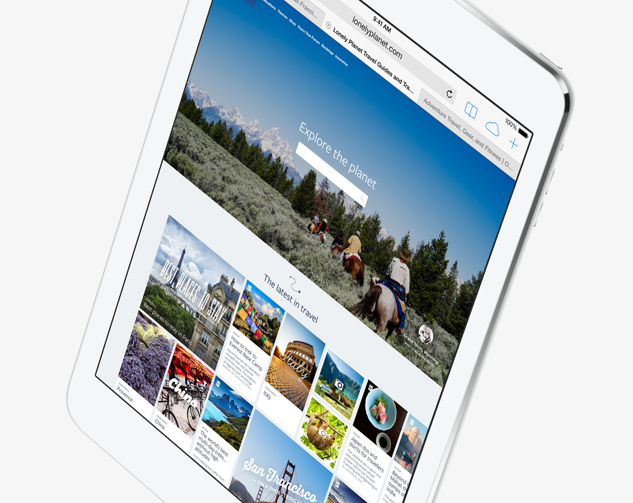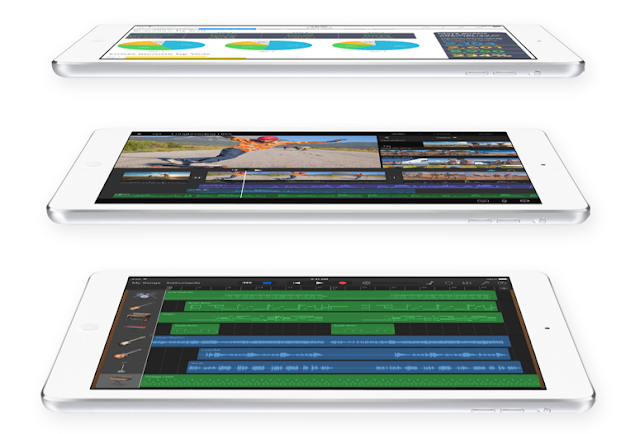The New iPad Air: Light Yet Powerful
The iPad Air is the new flagship tablet that the Cupertino company has to offer. It brings together the best of the iPad with Retina display and the iPad mini. It now has features such as
the A7 chip with 64-bit architecture and M7 motion coprocessor, advanced wireless connections, and its new svelte body. But is the iPad Air worthy of its flagship position?
The
iPad Air comes with a unibody aluminum
construction, similar to the iPad mini but in a bigger shell. It comes in both Space Gray and
Silver color options. It is also one of the sleekest and lightest 9- to 10-inch tablets around measuring 240 mm x 169.5 mm x 7.5 mm and weighing only 469 grams. The biggest change in its appearance is perhaps the slimmer bezels, which made the iPad Air look more premium and compact.

It packs Apple's new A7 processor,
which has faster CPU and graphics performance when compared to the previous generation. It is also among the first tablets in the world to have a 64-bit desktop grade architecture. Along with the new A7 chip,
the iPad Air also packs the new M7 coprocessor. It is designed
specifically to measure motion data from different sensors such as the 3-axis gyro and accelerometer.
Sporting the same 9.7-inch multi-touch Retina display of
its predecessor, it still maintains its 2,048 x 1,536 display
resolution and pixel density of 264 ppi. The display is protected by a
fingerprint-resistant oleophobic coating. It will run on
iOS 7 out-of-the-box and will contain apps such as
Passbook, Newsstand, and Game Center. iPhoto, iMovie, and the iWork
Suite (Keynote, Pages, Numbers) can also be downloaded for free with the
new iPad Air.
The iPad Air packs the same 5-MP iSight primary camera with
ƒ/2.4 aperture, backside illumination, five-element lens, and hybrid IR filter found in the iPad mini and iPad mini with Retina display. Camera features such as
autofocus, tap to focus, face detection, and photo
and video geotagging are all on-board. The camera is also capable of 1080p FullHD video recording at 30 fps.
A front-facing Facetime camera
can also be found, capable of shooting 1.2-MP photos and 720p HD video
recording. There is also backside illumination sensor on the front cam. Through it,
Facetime can be done via Wi-Fi and cellular network.
In
terms of connectivity, the iPad Air comes in both Wi-Fi only
and Wi-Fi + Cellular models (LTE-capable). It also has 802.11a/b/g/n
Wi-Fi and
Bluetooth 4.0 wireless technology. Noticeably lacking is NFC support.
Virtual assistant Siri is on-board, which you
can use to search, send messages, make a call, set reminders, and more.
It
has a built-in rechargeable lithium-polymer battery, which can
be charged through USB or a power adapter. Battery life is rated at up
to
10 hours while browsing on Wi-Fi (9 hours on cellular data), watching videos and
listening to music. The iPad Air Wi-Fi + Cellular
model will only accept nano-SIM to operate and
will have to rely on a Lightning connector for charging, unless you buy a
separate dock. Pricing starts at $499 for the 16GB Wi-Fi only model up
to $929 for the 128GB Wi-Fi + Cellular model.
This is probably Apple's best iPad yet. Essentially the same as the iPad mini with Retina display, their difference mainly relies on the size of the screen and pixel density. With its bumped up specs, the iPad Air can now match spec-by-spec some Android juggernauts (Samsung Note tablets, ASUS Transformer tablets, LG Pads, and the Sony Xperia Z tablet) and Windows 8-powered alternatives such as the Surface and Lumia tablets. And if that doesn't make you pick the iPad Air over its competitors yet, you should probably know that Apple has the largest repository of tablet-optimized apps - around 475,000 of them. Now beat that!
|
|
Note: Images came from Apple's website.
Til then...
xoxo Nash




























1 comments :
Gone are the days when the tablets and smartphones are very heavy now we have this innovative idea that reduces the weight of these devices very light.
Thanks
Charlie Electra
Buy Electronic Products
Post a Comment